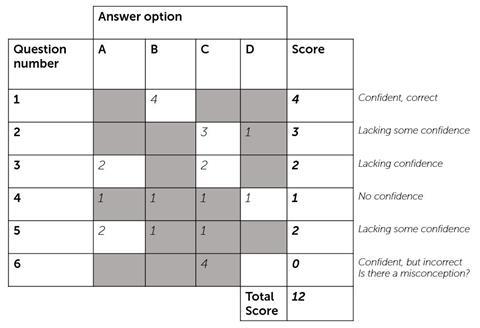How multiple-choice questions can motivate students to assess their own confidence and knowledge – without even knowing it

Self-assessment data is information about student progress, provided by the student. Asking students to assess their own work can improve their progress, and their understanding of learning objectives and assessment criteria. However, self-assessment data often includes learners’ opinions about their academic abilities and the progress they think they are making. How can you get a clearer picture?
Multiple-choice questions (MCQs) in a grid format for students to enter their answers can motivate students to self-assess correctly, and to perform better. The grid format displays question numbers (eg 1–6) down one vertical side, and the possible answer options (eg A–D) across the top.
Students distribute four marks for each question across the answer options in a strategic way to gain the best possible score. There is only one correct answer for each question. If the student is 100% confident, they give all four marks to one answer option. If they can’t decide between two options, they might give two marks to each, or split the marks three-to-one. If they have no confidence in their answer, they can give one mark to each answer option to guarantee a point.

The marking process is easy and quick, and gives almost immediate individual feedback to students. Create a copy of the answer grid on an acetate sheet with incorrect answer boxes shaded. To mark the answer grid, place the acetate over the answer sheet and points awarded to correct answers remain visible. Copy the points in any visible boxes into an additional column. Add the points in this column to give the final score.
Students are unaware they are providing self-assessment data as they focus on maximising their score. However, their answer strategies give a clear indication of a student’s confidence.
Teachers can use these answer-grid MCQs across many educational settings, including: high- and low-stakes assessments; open- and closed-book quizzes; and end-of-semester course tests. Whatever the setting these MCQs are used in, you need to use answers in feedback discussions with students to reap the key benefit.
How to approach feedback discussions:
- Did students lack confidence, or were they over-confident or well calibrated when giving their answers?
- What are their common misconceptions (shown by their confident, but incorrect, answers)?
- What strategies could they use to improve their content knowledge and their confidence in that knowledge?
The answer-grid MCQ combines performance assessment, feedback, confidence estimates and incentives for students to perform into one easily administered tool. It is simple to use and allows self-assessment of knowledge and confidence, and immediate feedback on individual questions.
Download a blank version of the self-assessment grid (word or pdf)
Downloads
Self assessment answer grid 2 x 2
Word, Size 58.14 kbSelf assessment answer grid 2 x 2
PDF, Size 56.32 kb









1 Reader's comment